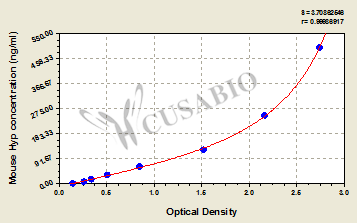-
中文名称:小鼠羟脯氨酸(Hyp)酶联免疫试剂盒
-
货号:CSB-E08839m
-
规格:96T/48T
-
价格:¥3800/¥2500
-
其他:
产品详情
-
产品描述:
This Mouse Hyp ELISA Kit was designed for the quantitative measurement of Mouse Hyp protein in serum, plasma, tissue homogenates. It is a Sandwich ELISA kit, its detection range is 7.8 ng/mL-500 ng/mL and the sensitivity is 1.95 ng/mL .
-
缩写:Hyp
-
种属:Mus musculus (Mouse)
-
样本类型:serum, plasma, tissue homogenates
-
检测范围:7.8 ng/mL-500 ng/mL
-
灵敏度:1.95 ng/mL
-
反应时间:1-5h
-
样本体积:50-100ul
-
检测波长:450 nm
-
研究领域:Signal Transduction
-
测定原理:quantitative
-
测定方法:Sandwich
-
精密度:
Intra-assay Precision (Precision within an assay): CV%<8% Three samples of known concentration were tested twenty times on one plate to assess. Inter-assay Precision (Precision between assays): CV%<10% Three samples of known concentration were tested in twenty assays to assess. -
线性度:
To assess the linearity of the assay, samples were spiked with high concentrations of mouse Hyp in various matrices and diluted with the Sample Diluent to produce samples with values within the dynamic range of the assay. Sample Serum(n=4) 1:20 Average % 89 Range % 82-97 1:40 Average % 98 Range % 91-104 1:80 Average % 98 Range % 96-105 1:160 Average % 97 Range % 92-102 -
回收率:
The recovery of mouse Hyp spiked to levels throughout the range of the assay in various matrices was evaluated. Samples were diluted prior to assay as directed in the Sample Preparation section. Sample Type Average % Recovery Range Serum (n=5) 96 92-101 EDTA plasma (n=4) 94 90-98 -
标准曲线:
These standard curves are provided for demonstration only. A standard curve should be generated for each set of samples assayed. 
ng/ml OD1 OD2 Average Corrected 500 2.656 2.755 2.706 2.553 250 2.088 2.187 2.138 1.985 125 1.492 1.518 1.505 1.352 62.5 0.841 0.850 0.846 0.693 31.25 0.506 0.515 0.511 0.358 15.6 0.337 0.349 0.343 0.190 7.8 0.262 0.271 0.267 0.114 0 0.152 0.153 0.153 -
数据处理:
-
货期:3-5 working days
引用文献
- Pulmonary Surfactant Homeostasis Dysfunction Mediates Multiwalled Carbon Nanotubes Induced Lung Fibrosis via Elevating Surface Tension X Li,ACS nano,2023
- ZC3H4 governs epithelial cell migration through ROCK/p-PYK2/p-MLC2 pathway in silica-induced pulmonary fibrosis R Jiang,Environmental toxicology and pharmacology,2023
- Ficolin B secreted by alveolar macrophage exosomes exacerbates bleomycin-induced lung injury via ferroptosis through the cGAS-STING signaling pathway X Wu,Cell death & disease,2023
- The Role of Cancer and Somatic Stem Cells in the Anti-Inflammatory and Antitumor Effects of Aconitum baicalense Extract on Experimental Breast Cancer OV Pershina,Bulletin of experimental biology and medicine,2023
- Anti-inflammatory and Antifibrotic Potential of Longidaza in the Bleomycin-induced Pulmonary Fibrosis A Pakhomova,/,2023
- Betulin and Crinum asiaticum L. bulbs extract attenuate pulmonary fibrosis by down regulating pro-fibrotic and pro-inflammatory cytokines in bleomycin-induced fibrosis mice model M Ofori,Heliyon,2023
- Customizable Resveratrol Spray-dried Micro-composites for Inhalation as a Promising Contender for Treatment of Idiopathic Pulmonary Fibrosis S Ahmed,International journal of pharmaceutics,2023
- IL-27 induces autophagy through regulation of the DNMT1/lncRNA MEG3/ERK/p38 axis to reduce pulmonary fibrosis L Ting,Respiratory research,2023
- Polyhexamethylene guanidine aerosol triggers pulmonary fibrosis concomitant with elevated surface tension via inhibiting pulmonary surfactant Xin Li,Journal of hazardous materials,2021
- Quantitative Functional Evaluation of Liver Fibrosis in Mice with Dynamic Contrast-enhanced Photoacoustic Imaging J Lv,Radiology,2021
- High-Intensity Interval Training Attenuates Ketogenic Diet-Induced Liver Fibrosis in Type 2 Diabetic Mice by Ameliorating TGF-β1/Smad Signaling Q Zhang,Diabetes Metab Syndr Obes.,2020
- Synthesis, construction, and evaluation of self-assembled nano-bacitracin A as an efficient antibacterial agent in vitro and in vivo Hong W.et al,Int J Nanomedicine.,2017
- Flavonoid Compound Icariin Activates Hypoxia Inducible Factor-1伪 in Chondrocytes and Promotes Articular Cartilage Repair. Wang P. et al,PLoS One.,2016
- Andrographolide Sodium Bisulfate Prevents UV-Induced Skin Photoaging through Inhibiting Oxidative Stress and Inflammation Janis Ya-Xian Zhan. et al,Mediators of Inflammation,2016
- Metabolism, health and fillet nutritional quality in Atlantic salmon (Salmo salar) fed diets containing n-3-rich microalgae Katerina Kousoulaki. et al,Journal of Nutritional Science,2015
相关产品
问答及客户评论
We are interested in sourcing Human, mouse, rat hydroxyproline,Hyp ELISA Kit from CusaBio. What would be our purchasing price for it?
Also, can you kindly clarify why they are a species specific elisa kit while hydroxyproline is a small molecule?
I will ask our distributor in your area to give you a quote by email.
Hydroxyproline is small molecule and it is the same in different species. There are 3 reasons why we have species specific elisa kits.
1. For different species, the sample matrix is different and the characteristics of antibody used in the kits are also different.
2. The methods of these 3 kits are different. Human kit and mouse kit are based on double antibody sandwich method.
When the kit was developed, it was designed to mimic the presence of hydroxyproline in vivo. It can detect polymerized form. (including the polymerized form with other proteins and self-polymerization form). For human kit, capture antibody is mouse monoclonal antibody and detection antibody is goat polyclonal antibody; For mouse kit, capture antibody is rat monoclonal antibody and detection antibody is goat polyclonal antibody.
Rat kit is based on competitive method. The plate is coated with mouse monoclonal antibody. HRP conjugated HYP competes with the HYP in the sample. The kit can detect the endogenous total HYP, including free form and polymerized form.
3. The reason why different kits use different methods is based on a variety of factors. You can choose the appropriate kit to avoid matrix problems.
Pls let me know if you have any further questions. Thank you.
Most popular with customers
-
Human Transforming Growth factor β1,TGF-β1 ELISA kit
Detect Range: 23.5 pg/ml-1500 pg/ml
Sensitivity: 5.8 pg/ml
-
-
-
Mouse Tumor necrosis factor α,TNF-α ELISA Kit
Detect Range: 7.8 pg/ml-500 pg/ml
Sensitivity: 1.95 pg/ml
-
-
-
-













